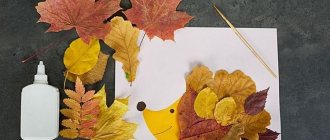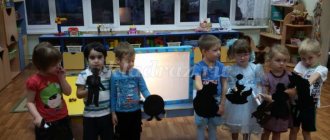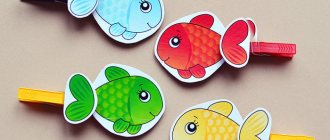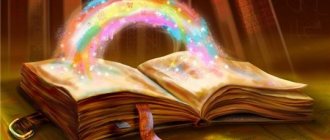Construction as a type of children's creativity
Definition 1
Construction is the process of constructing an object, bringing various parts, elements and objects into a certain relative position.
Construction is a type of children's activity during which the child constructs a specific object (according to a scheme, plan, spontaneously, etc.). Construction occurs by composing parts or elements (cubes, building material, natural material, waste material, etc.) in any order, depending on the type of construction.
Construction is of great importance in the development of a preschool child, in his mastery of various types of practical activities. By its nature, construction is a productive type of children's activity.
Are you an expert in this subject area? We invite you to become the author of the Directory Working Conditions
The main feature of design is that it is creative in nature, as it is aimed at obtaining a specific expected product. In addition, design is also defined as a special experimental research and search activity aimed at obtaining a total product consisting of individual elements. Also, a number of researchers consider design from a creative point of view.
In the design process, the child uses a variety of materials that have different characteristics (size, shape, tactile sensations, etc.). By constructing from various materials, the child learns to generalize, masters universal skills for constructing a single whole from a set of elements.
Definition 2
Creative design is a complex system of practical and mental actions aimed at solving a specific constructive problem.
Finished works on a similar topic
Course work Designing from natural materials as a means of developing children's creativity 480 ₽ Abstract Designing from natural materials as a means of developing children's creativity 250 ₽ Test work Designing from natural materials as a means of developing children's creativity 190 ₽
Receive completed work or specialist advice on your educational project Find out the cost
Creativity in construction consists in the fact that a child, while engaged in construction, carries out such processes as thinking and planning his upcoming activities, translating an incipient mental concept into a real creative product.
Note 1
Thus, children's creative construction has a comprehensive impact on the child's development. It promotes the formation of a variety of practical skills, as well as the development of speech, memory, thinking, imagination and fantasy of the child.
Swan
A swan - a bird made from cones - is quite simple to make, you just need to know the order of work. To make it, take a large semi-closed pine cone and white, black and red plasticine.
Use white plasticine to sculpt an oblong neck with a head, red for the beak, and black for the eyes.
Attach the plasticine blank to the blunt end of the pine cone.
The swan is ready!
If desired, the wings and tail can be made from dry grass or real feathers. To sculpt a black swan, you need to use black plasticine instead of white.
Types of children's design
Depending on what material is used for construction, its types are distinguished:
- Construction from building materials is a type of construction that uses specially created objects and elements (cubes, cylinders, prisms, bricks, Lego parts, etc.). When using a set of building materials for construction, the child can design both according to the scheme and according to his own ideas.
- Paper construction is a type of construction when paper is used as a material, from which children construct various figures, objects, etc. This type of design is also called origami.
- Construction from natural materials is a type of construction when pebbles, cones, acorns, leaves, stems, etc. are used as building materials. From natural materials, children, under the guidance of a teacher, construct various crafts and toys.
- Construction from waste material is a type of construction in which everything that seemed necessary to be thrown away, but can be used for creativity (capsules from chocolate eggs, baby food jars, cotton pads and sticks, etc.) is used as material.
Each type of design has its own characteristics. However, their fundamentals are the same - the child in his design reflects mainly real objects that have a certain practical significance.
Preparing natural materials for creating crafts
Materials brought from the forest are thoroughly cleaned of insects and debris. The buds are dried in the oven at 2500 for half an hour or in the microwave for 1 minute. at maximum power so that they open.
The leaves are dried either by ironing with a hot iron between layers of paper or the old fashioned way - between the pages of a book.
Shells are usually washed during rest, but upon arrival they should be washed again with the addition of bleach (you can use “Whiteness”) and dried on paper.
Stones should be washed with soap and water and dried.
Seeds, moss, and lichen can be dried on paper on a table or windowsill, and the branches can simply be placed in a vase without water.
If dried materials are not immediately used, put them in a large box or container so that they do not break or collect dust.
Crafts from acorns
These nuts do not have such a hard shell as walnuts and chestnuts, which makes them suitable even for making jewelry.
Beads
Materials:
- acorns;
- ready-made wooden or plastic beads;
- needle;
- strong thread;
- scissors.
Making beads will be interesting for a girl of 9-10 years old, when she already has the skills to handle a needle. You need to thread a thread (preferably a longer one) into a needle and start planting acorns, preferably across, alternating with beads. When the string of beads reaches the desired length, tie the ends and trim.
Three piglets
Materials:
- acorns;
- moss;
- branches;
- matches;
- plasticine;
- pruner
The craft looks like this: on a moss meadow there is a house made of branches and plasticine, and next to it are three pigs made of acorns. Each piglet has legs made of matches (sulfur heads - “hooves”), ears, a snout and a tail made of pink plasticine. The eyes are black.
The caps of acorns can be used as mushroom caps; all that remains is to mold them into white or yellow legs and place them around the clearing. The fairy tale plot is ready!
Crafts from leaves and seeds
In this category, applique takes 1st place, which can be designed simply on paper or cardboard, or you can make a painting or panel.
Applique meadow
Materials:
- black velvet paper;
- dried leaves;
- straw;
- ash lionfish;
- Dill seeds;
- dried cereal panicles;
- PVA glue;
- scissors;
- Frame.
The sheet is positioned vertically. The composition is being thought through. Using glue, cereals, straws and dried leaves are glued on, imitating grass in a meadow. Daisies are made from ash tree lionfish. From dill seeds - herb inflorescences.
Above the meadow is a butterfly, the body and head of which are carved from leaves, and the wings are birch and linden leaves; tendrils made from blades of grass.
It’s good if the leaves are of different colors: yellow, orange, red. But it also looks stylish in shades of yellow. The picture can be placed in a frame under glass - why not an original gift in eco-style?!
Crafts made from stones
Flat pebbles painted with acrylic paints look very colorful.
With children of preschool and younger school age, you can make simple ladybugs, berries, or simply paint stones with different patterns (dots, spots, stripes), and older children will be able to depict an owl, a cat, a house, and can cope with more complex crafts.
In order for the paint to stick better, it is recommended to first coat the stone with a layer of PVA glue diluted in water 1:1; such a primer will ensure a more even application of the paint. The finished product, when the paint has dried, is varnished (do it together with adults).
Materials:
- pebbles;
- acrylic paints;
- brush;
- PVA glue for primer;
- varnish (for fixing).
Ladybug
The top of the stone is covered with red paint. After drying, it is turned over and the “belly” is painted over with black. On the back, draw a semicircle in black and paint over the head, draw a line of wings in the middle and place the spots symmetrically.
Crafts made from nuts
From walnut shells you can make figurines of mice, turtles, spiders and beetles, as well as baskets and cradles. Whole nuts can be used to decorate a Christmas tree by wrapping them in foil and making loops; together with the cones, they can be used to make wreaths and candlesticks.
Little mice
Materials:
- walnut shells;
- plasticine of different colors.
Fill the shells with brown plasticine and turn them over. For each mouse, make plasticine blanks of the same color: 2 round ears and a thin tail, 3 small black balls for the eyes and nose. You can use bright colors for the tail and ears: it’s more fun.
If you need to complicate the work, place several mice on a sheet of cardboard around a triangular piece of cheese made of yellow plasticine with black holes of different diameters.
Crafts from pine cones
Cones occupy a leading position among natural materials used for crafts for kindergarten. While walking through the forest or park, the desire to fill your pockets with them arises involuntarily!
Pine trees make beautiful hedgehogs, lambs, owls, penguins and deer; spruce trees can be used to make butterflies with wings from dried leaves, foxes and squirrels. And if you attach loops to the little animals, silver or gild them, then full-fledged Christmas tree decorations are ready.
Cones are also used for interior decoration. Paint it in different colors and put it in a wide transparent vase - why not decorate the table? Or make a New Year's wreath decorating the front door or a candlestick.
Hedgehog made of cones
Materials:
- pine cones;
- plasticine;
- white gouache;
- brush;
- green cardboard;
- colored paper;
- scissors;
- a simple pencil;
- PVA glue.
Make a cone-shaped muzzle from brown plasticine and stick it to the base of the cone. Under the cone, make four legs from equal-sized pieces of plasticine, rolling them into small sausages.
The black ball is the nose. The eye consists of two parts: roll a white ball and flatten it, on top there is a black ball, very dotted, press lightly. Paint the ends of the cone scales with white gouache. Place plasticine apples or mushrooms on the hedgehog's back.
It is better to make crafts for school more complex in compositional terms. For example, make a clearing out of green cardboard, onto which you can paste flowers and leaves cut out according to a template (you can download from the Internet), make several mushrooms, and around it there is a family of hedgehogs: two larger ones and several hedgehogs.
Christmas tree
Materials:
- pine cones;
- plasticine;
- white gouache;
- brush;
- cotton wool;
- white cardboard for the stand;
- red cardboard or foil for the star;
- a lid from a gift box or a plastic shallow bowl;
- beads
Use white plasticine to attach the cone to a circle of cardboard. Roll New Year's balls of different colors and sizes from plasticine and secure them between the scales of the pine cone. Even a three-year-old can easily cope with such a task.
You can make a festive spruce forest. Why cover the cones with frost - white gouache, not completely, but the tips. Secure it with plasticine at the bottom of a lid or bowl, cover it with “snow” (cotton wool), and decorate it with beads. You can place stars cut out of red cardboard or foil on the tops of your heads.





